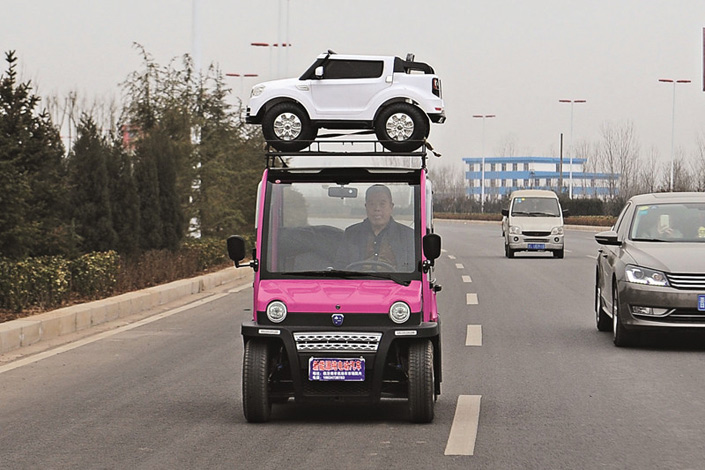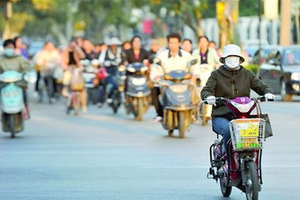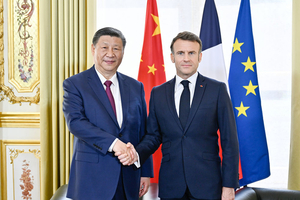Size Matters: Fate of Quadricycle Industry Rides on Classification

(Beijing) — The fate of the multibillion-yuan quadricycle industry is riding on how regulators decide to classify the four-wheel electric vehicles.
Resembling small cars or buggies, quadricycles — which have satisfied demands for motorized transport in rural China — still do not have an official classification.
The general understanding is that the “low-speed electric vehicles” run solely on electricity and can reach a maximum speed of 70 kph with engines much less powerful than that of an automobile.
Typically priced between 10,000 yuan ($1,460) and 30,000 yuan, these inexpensive alternatives to cars have been selling like hotcakes in third- and fourth-tier cities, with their main markets in the northern provinces of Henan, Hebei and Shandong.
According to estimates by Caixin, over 1 million such vehicles were sold in 2016, more than twice the number of electric vehicles (EVs) or hybrids sold in the same period.
But the flourishing industry has been hindered by the failure to categorize quadricycles as cars or motorcycles, leaving it languishing in legal limbo.
The sector has experienced a 30% slump in sales since January, a 50% annual growth stalled by regulatory uncertainties, as consumers wait for a verdict on where the vehicles stand. Industry standards and regulations were expected to be decided during the National People’s Congress meeting in March. But the tangle of interested parties has tied down the decision-making process.
The industry has its fingers crossed that quadricycles will be considered motorcycles rather than cars. This is because stringent licensing procedures and manufacturing requirements imposed on cars will wipe out all but a handful of quadricycle makers, which are often small workshops.
“Things would be far less devastating if quadricycles are classified as motorcycles,” said a person involved in the building of such vehicles. “Larger manufacturers will then be able to afford to upgrade their products, assured of their legitimacy, while weaker firms will be driven out of the market.”
But regulators seem indifferent toward the negative impact their deliberations are having on the industry, as they are more concerned about safety standards.
“When drafting national standards, we want to take into account public interest, market demands, and the impact on manufacturers, in that order,” said Dong Yang, a leading member of the team of experts that is drawing up guidelines for quadricycles.
“The classification of quadricycles is perhaps the single most complicated and delicate issue in China’s auto industry.”
Dong believes that the success of quadricycles has been largely due to the fact that they have been quasi-legitimate from the start, thriving in a regulatory gray area and enjoying the best of both worlds in terms of vehicle performance and government oversight. Many of these vehicles have maximum speeds and other functions on a par with automobiles, yet have dodged strict quality controls, manufacturing inspections, and insurance and licensing procedures that are mandatory for carmakers and drivers.
For example, driver’s licenses are not currently required to take a quadricycle on the road. Neither car nor motorcycle inspectors are directly responsible for overseeing the quality of these vehicles.
Lax regulations such as these combined with low prices have to a great extent been the reason for quadricycles’ popularity. But advocators believe consumers have voted in favor of the rise of these buggies, which were once marketed as simple mobility scooters for seniors.
“Quadricycles are upgraded versions of motorcycles — they offer an affordable, sheltered form of motorized transport,” said Lu Fujun, president of quadricycle manufacturer Fulu Motors.
They have satisfied increasing demand for automated transport in China’s villages and low prefecture towns, prospering despite their semi-legal status with few policies to support their growth.
Their prospects looked the most promising around 2012 in the northern provinces. Shandong’s government procured a total of 1,300 buggies in three consecutive years, and issued plans to boost its annual production to 300,000 by 2015 and 1 million by 2020.
Less wealthy governments such as Hebei and Henan began tentatively testing the waters in 2012, launching quadricycle-friendly pilot zones that readily offered licenses to vehicle makers and drivers, and spelled out manufacturing standards for firms.
But this system was exploited, and many of the four-wheelers were soon speeding down highways. Salesmen assured drivers that licenses were not necessary. “The traffic police don’t really care,” drivers were told.
Change soon came, however, when central regulators began contemplating automobile classification in 2014.
Although running on electricity, the in-between buggies by then had been excluded from the new-energy-vehicles category when the nation drew up a blueprint for the heavily subsidized industry in 2012. “Low-velocity electric vehicles are not considered EVs,” keeping quadricycles from the elite club consisting of EVs, hybrids and hydrogen fuel-cell cars, an official at top national planner the National Development and Reform Commission (NDRC) said.
Still waiting for policymakers to deliver them from the legal gray area, quadricycles are losing their edge when competing against heavily subsidized EVs, many of which are also at the lower end of the price spectrum.
“Quadricycles run on lithium batteries just like your normal EV, but don’t get awarded any subsidies,” said Yang Anzhi, director of research at the lab of electric carmaker Levdeo. “EVs sell at 50,000 yuan, and that’s pretty hard to beat when you discount at least 20,000 in subsidies.”
Draft rules published in December have prohibited quadricycles from installing lead-acid batteries, which cost 5,000 yuan each, and forcing them instead to use lithium batteries, at double the price, constituting as much as half the total cost of these vehicles.
This is due to pollution concerns, and is a step that analysts such as Yang Yusheng from the Chinese Academy of Sciences believe is going too far.
“Pollution from lead-acid batteries is a result of poor recycling management, and that is where efforts need to be ramped up,” he said, “Banning them once and for all is not the answer. The market should decide.”
Other requirements in the draft rules, such as setting size restrictions and passing crash tests of over 40 kph, have also been widely disputed by the industry. Carmakers think the requirements overly restrictive, much more demanding than the standards in the European Union for quadricycles.
“Tens of thousands of quadricycles are exported to the EU each year, and we’ve had no problems complying with the standards there,” manufacturers in Shandong province told Caixin. “Somehow, we don’t measure up to the draft guidelines.”
Dong said that there is little chance the official laws will be relaxed. “Compared to standards used by Japan, we are already extremely lenient,” he said. “Our aim is simple — we want them smaller and safer. After all, safety is a matter of life and death to consumers.”
Quadricycle makers are holding their breath as they wait for the document that will decide the industry’s fate. But interest is dwindling in these vehicles, which have proved to be the subject of so much regulatory risk.
“We don’t want to be left hanging much longer,” said Wu Shiyin, sales director at quadricycle maker Yomogo.
Contact reporter April Ma (fangjingma@caixin.com)

- MOST POPULAR






